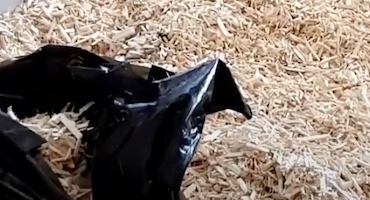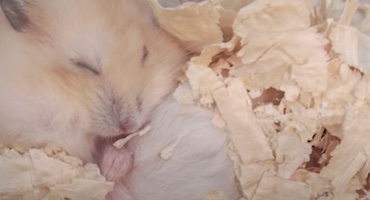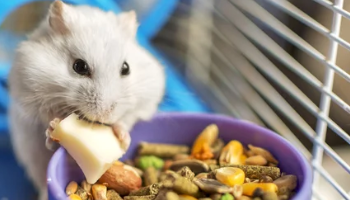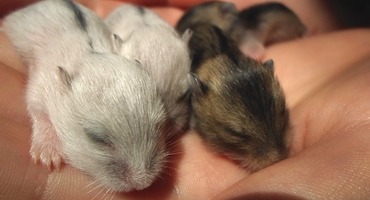Dwarf hamsters are the smallest of the hamster breeds. Their cuteness and size make them a trendy pet. Breeding your Dwarf hamsters will be a challenging but rewarding process. This guide will walk you through on how to breed Dwarf hamsters.
This guide will be suitable for all the Dwarf hamster types. This includes the Roborovski, Winter White, Campbell’s, and Chinese Dwarf hamsters.
Things to Consider
How many babies can Dwarf hamsters have?
Caring for a family of tiny fur balls takes a lot of work. Dwarf hamsters can have anywhere between 8 to 12 pups! The animal’s safety and health need to be taken into consideration. If your dwarf hamster is sick, weak, or old, do not breed them.
What kind of plans should be made?
Planning ahead is the best start for you and your hamster. Will your Dwarf hamsters be sold? Will you adopt them out? You can keep the pups at home, but that is a big responsibility! Dwarf hamster experts will go above and beyond to find the perfect pet.
Preparing to Breed your Dwarf Hamster
Where should I get the Dwarf Hamsters?
You need to get your Dwarf hamsters from an experienced and seasoned breed. They will be the best option to get a sturdy pair of hamsters. The breeder will have lots of information! This includes genetics, family trees, and bloodlines. Knowing the background of your Dwarf hamsters will help leave out possible genetic deformities.
Chain pet stores are the worst place to get Dwarf hamsters for breeding. These hamsters are not monitored; meaning they just breed to produce babies, no matter the genetics. Not knowing where they came from could cause possible genetic inconsistencies.
Dwarf hamsters need to be around the same age. 4 to 12 months is around the best time for your Dwarf hamster to give birth to healthy pups. Breeding older hamsters will be harmful to their health and the pup’s health.
What supplies will be needed?
Dwarf hamsters need a comfortable environment to stay in. Purchase or make a cage that will be able to fit lots of Dwarf Hamsters! Planning the space is essential in making all the critters feel at home.
Prepare a backup plan in case the mother rejects her pups. Get an eye dropper and kitten formula. The Dwarf hamsters will be good with Cat milk. This is the next best thing since cat milk is very similar to Dwarf hamster milk.
How should the male and female Dwarf hamsters be introduced?
Their cages need to be in the same room. Getting to know each other’s smells will prevent possible fights. The introduction process is best to take slow, so leave the hamsters like that for about a week. The breeding process will be more comfortable since the Dwarf hamsters will already be familiar with their different smells. Too early of an introduction can cause hostility between the male and female hamsters.
Take a clump of their bedding and put it in the opposite cage after about one week. The Dwarf hamsters will become closer but still be at a distance. The Dwarf hamsters are ready to be able to see each other! Push their cages close together so they can meet face to face.
Have a neutral cage set up. The breeding process will occur here. The neutral cage will not be as stressful for the male and female Dwarf hamsters. There are no chances of stress because the pen is smell free! Like all enclosure, this should contain fresh water, food, bedding, and a hide house.
Can two or more Dwarf hamsters be kept in the same cage?
Yes! Dwarf hamsters are social by nature. It is better for them to have cage mates. When following the introduction instructions, your male and female hamsters will be perfectly safe together.
Breeding your Dwarf hamsters
How will the female Dwarf hamster show she is in heat?
Determine if your female Dwarf hamster is in heat before placing into the neutral cage. When you go to hold the hamster, gently touch the top of her rear. She will suddenly freeze, and then lift up her tail.
How will the Dwarf hamsters begin breeding?
The Dwarf hamsters start this off by sniffing around each other. Then, if the female is in heat, will lift her tail up. Once the male recognizes the gesture, he will mount the female. Stay to observe and make sure no fight breaks out.
How long does it take for a Dwarf hamster to mate?
It will take between 10 and 15 minutes for the Dwarf hamsters to breed. Once they are done, they will go about their business. Record the time and date when the breeding took place. This will aid in determining the birth date for your female hamster.
Prepping for the Birth
Carefully watch the female in the next coming weeks. Her mood will begin to change. A Dwarf hamster’s gestation period is between 20 to 22 days. You will be able to make an assumption on when the pups will be born by referring to the date you wrote down.
Make sure to clean out your female hamster’s cage before she becomes further along. Use paper towels, a brush with a pan, a safe cleaning solution, and a garbage bag. To prevent any bacteria from coming in contact with your skin, use rubber gloves.
Sweep the dirty bedding into the pan using the brush. Continue until there is no bedding left in the enclosure. Clean off debris from the sides of the cage. Use a vacuum to get into the tight spaces and corners.
Next, spray the cage down with your choice of a safe cleaning product. Get the spray on the bottom and sides of the cage. Wipe the wet pen down with a dry paper towel.
Put all of your Dwarf hamsters belonging in a sink to be washed. Take soapy water and rub the objects until its dirt free. The Dwarf hamster’s wheel will be especially dirty, so take extra time to clean it off. Rinse the accessories off when the washing is done. Towel dry the objects and set aside to air out.
Add paper-based bedding to the clean cage. There should be at least four inches of litter. Evenly distribute the bedding throughout your hamster’s cage.
Add food, water, toys, and a hide house. Because your female Dwarf hamster will begin nesting, add some extra fluffs. Ripped up paper towel and fleece can also be added as nesting material.
When will a female Dwarf hamster show signs of pregnancy?
The signs of pregnancy in Dwarf hamsters will begin to show 2 days before the birth. Handling your hamster before her due date is very dangerous. This will add stress to your Dwarf hamster and may lead to hurt pups.
Leave your Dwarf hamster be as the build their nest. She will use bedding, paper strips, and just about anything she can find to make the nest comfortable!
The female Dwarf hamster will chase away the male during birth. The male is safe to be there during the process. He may even help clean the pups!
Dwarf hamsters are nocturnal, so she will most likely give birth at night. Do not disturb or try to handle the mother and pups. Holding a newborn pup will transfer your smells onto it. The scent will confuse the Dwarf momma hamster. This will trigger her animal instincts, and the Dwarf hamster will possibly eat the pup.
Do hamsters eat their young?
This is a part of your Dwarf hamster’s natural instincts. The female hamster may eat her pups if there are too many babies. By eating them, this will reduce the “competition” for food. If the Dwarf hamster does not recognize her pup, she may eat it due to being a possible threat.
Taking Care of the Litter
The female Dwarf hamster will keep her babies in the nest to protect them. The pups will look pink and hairless. Dwarf hamster pups are born with their eyes closed.
Make sure the mother hamster has all that she needs, but do so without disturbing her. Quietly top off her food and water when needed.
The babies are okay with their mother’s milk. The pups get everything they need from nursing. They may begin to explore outside the nest.
When should the hamster pups be introduced to solid food?
One week after birth is an excellent time to give them solid food. The pups will enjoy small portions of vegetables. Cut up light vegetables such as broccoli, carrot, and spinach. The female Dwarf hamster will hide food in her nest as well.
After about one week, check the health and development of the pup. Fur will begin to come out in the pups. The color will start to appear in their hair. Babies will start to explore outside of the home, but the mother or father hamster will scoop up the pup in their mouth and bring them back to the nest.
When should the next cage cleaning be?
Clean the cage two weeks after birth. Set up a safe area to put the mother and her pups. Use only water to clean out the enclosure. Keep the nest put together. Replace the bedding if it is soiled and wet.
Spot clean every day to reduce the amount of build up between cleanings. Rub bedding in between your hands to get the pups used to your natural smell. The newborns will smell you on their bedding, so when you handle them, the babies know who you are.
Your baby Dwarf hamsters will be able to explore, eat, and drink by themselves at the two-week mark. The mother will still keep a close eye on the babies to make sure they stay out of trouble.
Checking the gender of the pups can be a tricky process. Look at the area between each hamster’s anus and genital opening. The distance between males will be longer than the length of a female. By four weeks, the males’ testicles should also be noticeable, as should the nipples on the females’ bellies.
At what age should Dwarf hamsters be separated?
You will now be able to divide the Dwarf hamster pups by gender. Prepare two cages; one for the males and one for the females. Gently pick up the babies and separate them to the appropriate cage. You can also pick the pups up by the scruff on their necks.
Hamsters are all different, so some might take longer to develop. Do multiple checks of their gender before separating them. Take the babies to your vet to make sure. This will prevent unwanted breeding.
When should the Dwarf hamster pups be socialized?
About 30 days after birth, the pups will be ready to socialize with you. To start, let the pups come to sniff your hand. You can offer them fruits or veggies to entice the babies. They may nibble you a bit as the babies get to know you.
The Dwarf hamsters will be ready to leave home at 35 days. This is a great time to have the pups adopted out. Give your clients as much information as possible. This should include the parent’s bloodline, the date of birth, and what food you have given them.
Conclusion
Breeding Dwarf hamsters is a difficult feat, but the end result is cute and hearty fur balls. Having happy and healthy pups is always the end goal. Dwarf hamsters are co-dependent, so the male and female are safe to live in the same enclosure. Before you consider breeding, have a well thought out outline to follow. The Dwarf hamster knows what to do, so do not disturb her before, during, and after birth.
Share
Related Posts
Hamsters are recognised for being cute and cuddly critters that make terrific pets. However, there are also occasions [...]
Syrian hamsters are a great addition to anyone's family. They make a great pet to teach your [...]






